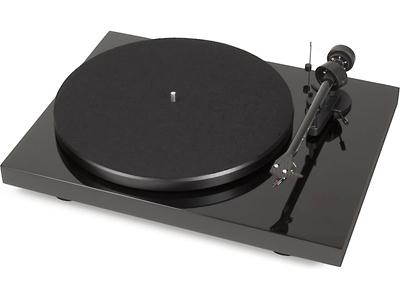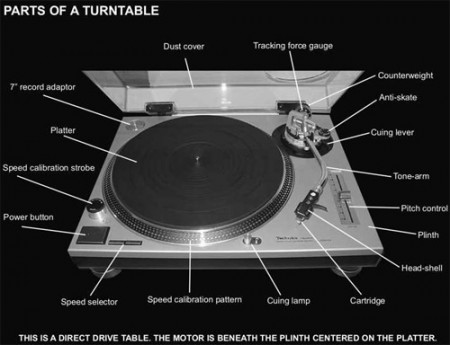While vinyl records might have been before your time, it doesn’t mean you can’t enjoy a needle hitting the groove, even in an age where the iPod is already old hat. Newcomers to the scene have a lot to get familiar with when buying a record player, learning about its parts, and knowing how to hunt for used record. Let’s start off with the basics of records 101:
1. What is the best kind of record player?

Depending on how you’re going to be using your turntable, you basically have one of two options, depending on how you will use your record player:
Belt Drive
This turntable’s platter sits atop a bearing that rotates by an elastic belt connected to a motor on the side. The belt helps to minimize any vibrations or noise from the motor by absorbing the waves.
Ideal for: home listening, people on a budget
The bad: can be slow, rubber belts need replacing after a while, inconsistent pitch and speed (wow and flutter)
Recommended Models:
- Audio Technica AT-LP120-USB ($250-300)
- Pro-ject Debut Carbon Turntable ($350-400)
- Audio Technica AT-LP60 ($100)
Brands to look out for used: Audio Technica, Music Hall, Rega
Direct Drive
The platter of a direct drive turntable is placed directly over the motor instead of off to the side, this allocates more power for a cleaner and consistent sound. This is the preferred table for DJs and musicians, as you can play the record backwards, scratch, and generally
Ideal for: DJs, audiophiles
The bad: can be rumbly, expensive, often come in pairs
Recommended Models:
- Technics SL-1200 ($400-3,000)
- Pioneer PLX-1000 ($700)
- Stanton T62 ($200)
Brands to look out for used: Technics, Numark, Vestax, Stanton, Pioneer
Manual or Automatic: A manual turntable requires you to place the needle on and off the record, an automatic will play and stop automatically.
USB: If you’re looking to move vinyl record onto your computer, some newer tables have this functionality, although they usually have poorer performance than a standard record player.
2a. Record Player Parts and Equipment

Stylus (the needle), this needs to be upgraded the most, as it can wear out the fastest (every 1,000-2,000 hours)
Cartridge (the piece that holds the needle), a good cartridge is key to great performance. A new cartridge is needed if yours is damaged or you are looking to upgrade.
Pre-amp, unlike the plug and play world we live in now, a record player may need to convert the PHONO (output signal) to LINE (AUX signal) by hooking it up with RCA cables. Basically, it won’t work unless you have a middle man, especially with older tables, as new ones sometimes have a preamp built-in. A DJ mixer can suffice as a preamp as well.
Speakers or Headphones, If you want to start slow, you can go to your local thrift store and pick up some speakers, otherwise, you can pick some good ones up for relatively cheap nowdays. Headphones can be a bit expensive, but if you’ve grown up in the early aughts already, you probably know how good headphones are worth it.
2b.The Record Player Setup
There’s actually a fine science to setting up your record player, receiver, setup and speakers.
1. Keep speakers apart and away from turntable. They should be as far away from one another as they are to you and unable to shake the turntable from bassy vibrations.
2. Keep the speakers away from the wall
3. Raise your speakers (if possible)
4. Make sure your turntable is balanced and not hanging off a ledge
5. Keep vinyl records in plastic sleeves for protection, and upright like books–not in a stack. Make sure it’s not by a heater, window, or any other source where it could warp from temperature.
3. Buying Records: How to Buy a Used Record
- Move towards a bright light at the store you’re in
- Check out the record’s jacket to see if it’s heavily worn, this could indicate heavy use or damage
- Inspect the color and sheen of the record, is it shimmering with the tiny etchings of the grooves or is it grey, flat or dirty? The better it looks, the better it will sound. Sidenote: some records might just be a bit dusty but be near VG+, but some of the dirt can also hide scratches–try spitting on the record and wiping it down with your sleeve in the light to see if there are any marks. Or use some water from a waterbottle if you’re more civilized than that.
- Look at the edges of the record for wear, since the needle will hit this point first.
- Inspect the scratches–are they deep, cutting into the wax? If you can feel it you can hear it, so make sure to pay attention. Tiny scuffs aren’t too worrysome, you can still get some great playtime out of it even if the former owner decided it was no good. Look for parallel scratches towards the grooves, those are the worst.
- The balance test. To make sure the record isn’t warped, bring the record to eye-level make sure everything looks pretty flush. If the far edges are above or below the surface then you may have a warped record.
- Heat test. To check the record for heat damage, look for tiny crater-like patterns, that may even look foamy.
Buying a Used Record Online
1. This is mostly on a trust basis since you can’t physically inspect the item. Check the seller’s ratings, past items, and other indicators that you’re not dealing with a cheat.
2. You can also try firing up Photoshop to make sure it’s the real deal. Drag the seller’s image into your photo editor and adjust the levels to look for defects that the camera’s exposure may be covering. Image > Adjustments > Levels (Command+L is the shortcut). Drag the sliders around underneath the mountain-like picture and get a detailed look at the album. See example on the right:
4. Terminology
LP – long play
EP – extended play
Original Pressing/Issue – Vintage Record (not a reissue)
First Pressing/issue – First version of record, the rarest and highest desired
RPM – revolutions (of the record) per minute. Most 12″ albums will be at 33 1/3 speed, while EPs and other smaller records will be at 45 RPM/
180 gram vinyl – a heavier vinyl record that will not wear out as easily as other records, these can sound great on a subpar stereo system as well.
Warping – when a record bends its shape from heat, or another cause and distorts the shape.
Crate Digging – Scouring through record stores to find new or rare music (especially dollar bins)
Jacket – The insert which the record is packaged in, what protects the vinyl
